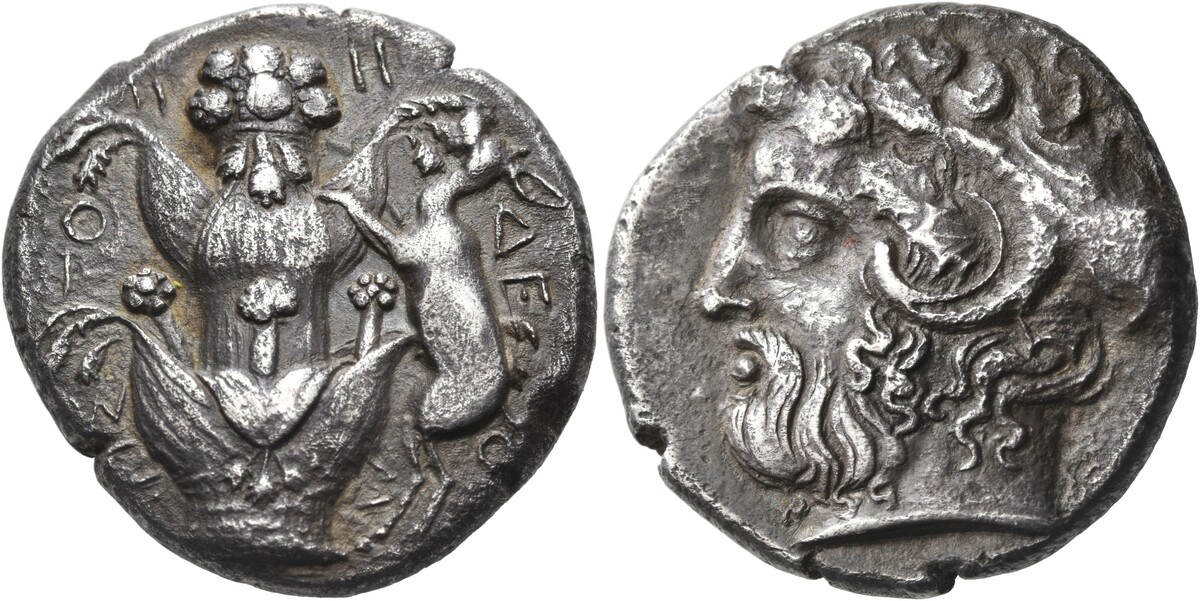Lot 1485

KYRENAIKA. Kyrene. Circa 410 BC. Tetradrachm (Silver, 24 mm, 12.94 g, 6 h). ΑΡΙΣ-ΤΟ-Μ-Η-ΔΕ-ΟΣ Silphium plant with four leaves (two on each side), and four flowers (a large one at the top and three smaller ones above the lower register of leaves); on the right, standing on its hind legs and propping its forelegs on the silphium, is a gazelle, raising its head - with a long ear and a stubby horn - to nibble on a silphium leaf. Rev. Bearded head of Zeus-Ammon to left, with carefully arranged hair, a ram's horn curled around his ear, and with a few tendrils of hair falling down his neck. Cf. BMC pl. XI, 11 (for the obverse) and pl. XII, 1 and 4 (for the reverse). (U. Wartenberg and J.H.Kagan, Silphium, Jerboas, Genets, and the Coinage of Cyrene, in Le Monete di Cirene e della Cirenaica nel Mediterraneo. Problemi e prospettive. Atti del V Congresso Internazionale di Numismatica e di Storia Monetaria, Padova, 17–19 Marzo 2016, ed. M. Asolati, Padova, 2016, pp. 43-56, especially pp. 50-51, 3 and p. 53, fig. 3 (this coin). An extremely rare type, with a particularly naturalistic obverse and a noble head of Zeus-Ammon on the reverse, masterfully engraved. Die flaw on the reverse, otherwise, about extremely fine.
From the Collections of Jonathan H. Kagan, and N. B. Hunt, IV, Sotheby’s 19-20 June 1991, 521.
This coin is quite extraordinary in every way. The head of Zeus-Ammon is of a refined yet powerful Classical style, reminiscent of the Dionysos on the contemporary issues of Thasos and of the more refined heads soon to be produced at Olympia. However, it is the obverse that really catches the eye. What we have is a remarkably lively scene of an animal browsing on a silphium leaf, surely originally drawn from nature. Thus, unlike most ancient coin types, which are probably taken from sculpture - whether in the round or in relief, this type seems to be based on a painting or a drawing. It is quite clear, with the only problem being the identification of the animal on the obverse. Robinson, BMC p, li, description of 92a, called him a gazelle. On the contrary, W & K, in their masterful article cited above, believed that the animal was a genet (in fact, 'The Common Genet' Genetta genetta (Linnaeus), the habitat of which is North Africa - though not in much of Libya, at least in modern times), which is a cat-like creature with a pronounced neck, a long tail and large ears. They also pointed out that gazelles have horns, of which they saw no sign on this coin. However, from what we can see on this coin, and on the piece in Karlsruhe, BMC pl. XI, 10, this creature: has 1) long spindly hind legs, which genets do not have; has 2) a seemingly short and thin tail, unlike the thick bushy ones genets have; has 3) hind legs ending in hooves rather than the paws genets have; and has, clearly visible on this piece, to the left of the ear, 4) a short horn, which is depicted by a short vertical line ending in a knob (there is a clear space between the end of the knob and the edge of the coin; i.e., no part of the design is cut off), and genets do not have horns.Thus, the old identification of the animal on this coin as a gazelle seems certain. In addition, while some have suggested that the silphium was such a small plant that gazelles would not have had to rear up to browse on them - while genets might have had to do so (assuming they, as carnivores, had a taste for silphium leaves), we actually know, from a number of representations on coins (as BMC 11-12 and pl. II, 20-21, BMC 12a-12b and pl. III, 1-2) that silphium plants could be quite tall: the ones illustrated come up to the height of the head of a seated goddess. In another case a standing gazelle is browsing on leaves at the top of a silphium (BMC 15a and pl. III, 6).
